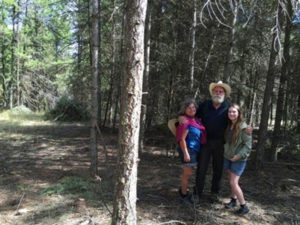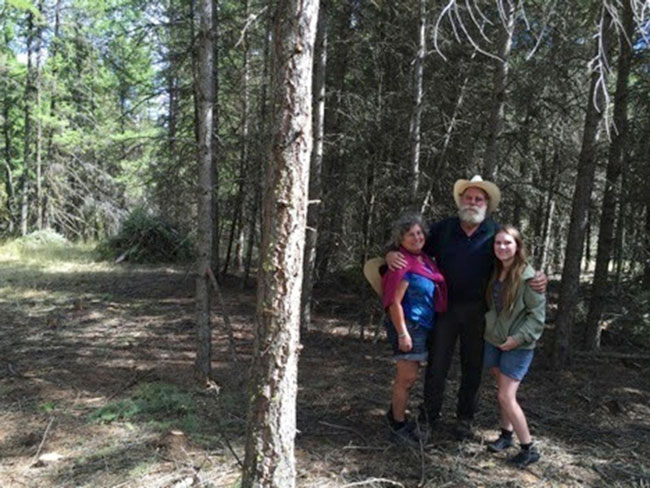Submitted by Sarah Troutman
sarah.troutman@wa.usda.gov
When dust storms and giant fires stress a community, people are unwilling to put down roots. But when the streams run clear and the meadows are green as a result of responsible land management, neighbors invest more in each other and feel the community is stable.
John and Tree Kiesecker, who own 220 acres of forestland and 340 acres of rangeland near Wauconda, Wash., manage their property with their community in mind. The Kieseckers focus their efforts primarily on forest and ecosystem health – a strategy they have passed on to their daughter, Lydia. Lydia Kiesecker, who is in her final year of college studying social work, sees land health as being integral to the health of a community. Although some landowners treat the property strictly as an economic resource, the Kieseckers prioritize conservation.

Tree, John, and Lydia Kiesecker standing by a completed thinning unit (left of photo) and a piece to be completed this fall (right of photo).
“This is our home – this is where we want to be,” said John Kiesecker. “You want your living environment to be healthy, for your life time and into the future.”
With financial and technical assistance from USDA’s Natural Resources Conservation Service, the Kieseckers have thinned approximately 50 acres of the forestland. They also plan to start another 22 acre thinning project soon to remove diseased and suppressed trees, prune branches to reduce ladder fuels, and clear dead wood from the forest floor.
John Kiesecker says NRCS programs help him stay on track with their land management goals. “[NRCS] has many different individuals experienced in a variety of fields who are always willing to listen to our specific challenges. They have walked our place with us in every season over the years – including deep snow – and are a part of what we are succeeding at.”
Financial assistance available through NRCS’s Environmental Quality Incentives Program is also helpful, Tree Kiesecker points out. “We have been able to hire neighbors to help us pile brush. That income has helped save some of them from difficult times.”
John Kiesecker recommends all forestland owners make their property as fire safe as possible, and to take advantage of the technical and financial assistance from NRCS.
NRCS is currently accepting EQIP applications from non-industrial private forest landowners and tribal forestland in Chelan, Kittitas and Okanogan counties as a result of the Joint Chiefs’ Landscape Restoration Partnership. The goal of the Joint Chiefs’ Landscape Restoration Partnership is to improve the health and resiliency of forest ecosystems where public and private lands meet through a partnership between the U.S. Forest Service and NRCS.
Although EQIP applications are accepted on a year-round basis, eligible producers and entities interested will have two cut-off dates to submit their applications for consideration for funding in fiscal year 2017. The cut-off dates are as follows: Feb, 17, 2017, and April 21, 2017.
In order to be eligible, it is important interested parties visit their local USDA Farm Service Agency (FSA) office as soon as possible to ensure their farm records are established. Each applicant must establish themselves as a USDA customer and complete all FSA eligibility requirements prior to the application cut-off dates.
Applicants who apply as entities must provide a Data Universal Numbering System (DUNS) number, be registered in the System for Award Management (SAM), and maintain an active registration with current information prior to applying for funding and to remain eligible for payments under a funded contract. For more information regarding SAM and DUNS, or if interested in applying for EQIP funding, contact the local NRCS field office, located through the web site at: www.wa.nrcs.usda.gov.
To learn about technical and financial assistance available through conservation programs, visit www.nrcs.usda.gov/GetStarted or a local USDA service center.






